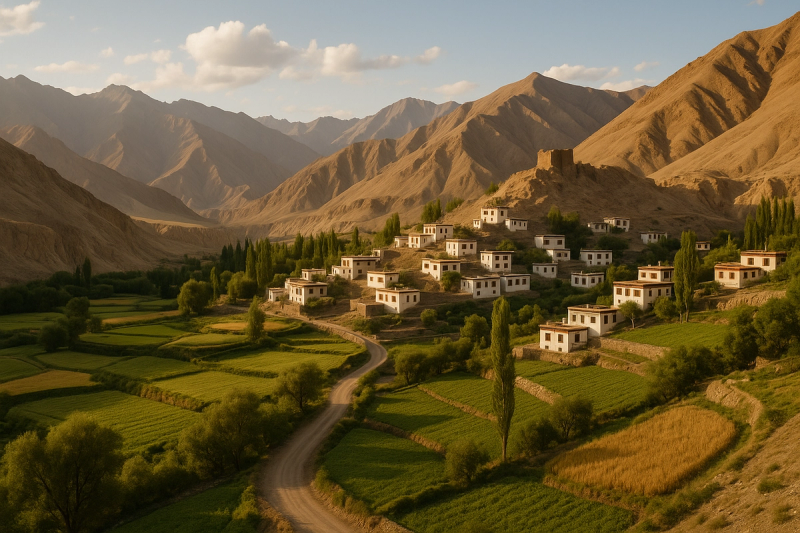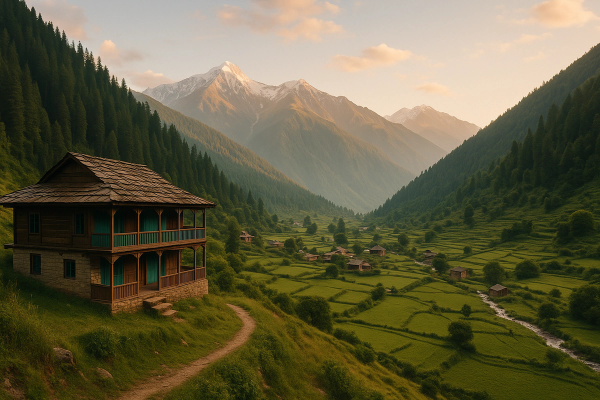Offbeat Ladakh: Hidden Villages, Culture & Landscapes Beyond Leh — the trip that messed me up (in a good way)#
I’ve done the Leh–Khardung La–Pangong circuit like every other desi traveler, clicked the classic blue lake pics, felt cute hypoxia and all that. But this time I wanted something different — the quiet side of Ladakh, where the maps get patchy, homestays smell like butter tea, and you meet people who’re not trying to sell you yak-wool caps (ok sometimes they do, but gently). And honestly, going off the usual route changed the whole vibe of my trip. It felt slower. More personal. And, um, a little chaotic in the best way.¶
Why go beyond Leh (and the big-name spots)#
Leh is the hub, no doubt. You land, acclimatize, chomp on momos. But the soul of Ladakh lives in the tiny villages stitched across Sham Valley, Nubra, Zanskar, and the Changthang plateau. Out there it’s apricot orchards, centuries-old monasteries with paint peeling in the most aesthetic way, and the kind of hospitality where the aunty will push a third helping of skyu even when you’re already so full. It’s quieter, cheaper (mostly), and the culture hits different because you’re not just breezing in and out for one selfie.¶
My route — sort of planned, mostly vibe-based#
I kept Leh as base for permits, fuel, snacks, and then did small loops:¶
- Sham Valley: Hemis Shukpachan, Yangthang, Temisgam/Tia, Ulley
- Nubra: Sumur, Turtuk, a cautious hop toward Tyakshi (border vibes)
- Changthang: Hanle for the dark sky goodness
- Zanskar side: Photoksar via Singay La, plus slow hours in Alchi & Mangyu
Sham Valley homestays — the baby trek feeling without the trek-trek#
Hemis Shukpachan is this breezy, juniper-scented village where time moves like a yak on a chill day. I stayed in a family-run homestay (around ₹1800–2500 per person with meals, cash preferred), slept under thick quilts, woke up to gur-gur chai. The aunty made skyu — a Ladakhi barley pasta stew — and told me how her son spotted a snow leopard near Ulley last winter. Ulley btw is a legit wildlife hotspot; several homestays here collaborate with local trackers. If you’re into community tourism, look up Mountain Homestays or the Snow Leopard Conservancy initiatives — they’re doing solid work with homestay training and sustainable income.¶
Temisgam and Tia surprised me. Temisgam has a little fort ruin and orchards that glow gold in late September, and Tia’s lanes feel untouched — murals flaking, old stupas, everyone saying julley with that effortless kindness. I paid around ₹1500 for a simple room, got khambir bread, apricot jam, and a quiet tea with a monk who had better jokes than any stand-up I’ve paid for.¶
Nubra beyond the dunes — Sumur and Turtuk felt like stories#
Most folks rush to Hunder for the Bactrian camel selfies, which is fun, but stay a night in Sumur. There’s Samstanling monastery, and the village is calmer, fewer horns, more birds. Homestays go ₹1200–2000 pp if you ask nicely and don’t try to negotiate like it’s a Delhi flea market. From there I rolled to Turtuk — and wow. The Balti culture feels different: wooden balconies, walnut and buckwheat fields, baskets woven like poetry. I had buckwheat roti, yak-milk tea, and chatted with a schoolteacher about how summers bring travelers but winters bring togetherness. Tyakshi and Thang sit right up against the LoC — access depends on current advisories, so don’t assume. On my day there, army checkpost was friendly but firm, the rulebook is real. Respect it, don’t push boundaries, definitely don’t fly drones near border areas.¶
Hanle — the dark sky where you stop talking and just… stare#
Hanle lies deep in Changthang, wind scraping your cheeks, stars doing their full-blown drama. It’s home to India’s first Dark Sky Reserve anchored around the Indian Astronomical Observatory. As of 2025, stargazing sessions run with local guides and simple telescopes, and villages are adopting low-light rules. Please keep headlights dipped, switch off balcony lights, and avoid light leaks — the sky here is a community treasure.¶
I reached by a long, shimmering drive from Nyoma. Road’s good in parts, but I hit a gravel stretch where my Bolero did tap-dance moves. Hanle homestays are basic but warm — ₹1500–2500 pp with meals. There’s Jio/BSNL postpaid in patches, but data is moody; don’t count on Insta Live under the Milky Way. I slept maybe three hours because the galaxy decided to just show off, like full river of light across the village. And the silence… it hums.¶
- Hanle tips: carry extra layers, windproof, a thermos and snacks. Nights get brutal.
- No loud music, no bright torches, no drone. The rules are not just “rules”, they protect the reserve.
- Fuel up at Karu/Leh and Diskit. No pumps in Hanle. Carry jerry cans.
Zanskar side: Photoksar and the road that felt like a secret#
Photoksar sits on the new Kargil–Zanskar road near Singay La. The scenery is lunar — ridges cut like origami, villages huddled by streams. The road is improving, but landslides do their thing after rain or sudden snow. I got stuck an hour behind a dozer, ate cold tingmo, chatted with a driver who’s done this route 100 times and still says, “Bhai, don’t hurry. Mountain has mood.” Homestays in Photoksar are community run, meals simple, stars heavy. If you’re prone to AMS, go slow, hydrate, don’t be a hero hiking the day you arrive. And yes, check if public buses are running; they’re infrequent but do exist — a bus or shared taxi can save your nerves.¶
Food, chai, and small cravings that Ladakh recieves with love#
I’m a shameless eater, so here’s what slapped: skyu in Hemis Shukpachan; thukpa at a tiny house near Mangyu; khambir with apricot jam in Temisgam; Balti buckwheat roti in Turtuk; tingmo with spicy veg in Alchi; and sea-buckthorn juice (locals call it tsermang) wherever you see a poster. Butter tea is an acquired taste, yeah, but when it’s minus-whatever, it’s divine. Pro tip: carry munchies but say yes when a family offers home food — it’s rude to refuse, and it’s usually the best meal of your trip.¶
Travel updates you should actually know (don’t skip this stuff)#
Permits keep changing, and I’m not gonna pretend this is evergreen. Recently, domestic Indian travelers generally don’t need Inner Line Permits for most areas, but registration happens at checkposts and certain border belts can switch to permit-only based on conditions. Foreign nationals require Protected Area Permits, and routes like Pangong–Tso Moriri direct, or parts of Changthang, can have extra rules. Always check DC Leh notices or drop by the Tourist Information Center near Leh main bazaar a day before heading out.¶
- Only postpaid SIMs from Jio/BSNL/Airtel work in Ladakh. Prepaid from outside J&K usually doesn’t. Connectivity is best around Leh, Diskit, Kargil; super patchy in Hanle, Zanskar.
- Fuel: Leh, Karu, Diskit, Kargil are reliable. Nothing at Pangong/Tso Moriri/Hanle. Carry spare.
- Rented bikes from Manali/Srinagar aren’t allowed for sightseeing in Leh region due to local union rules. Park them, hire a local bike or taxi.
- AMS is real. Acclimatize 24–48 hours in Leh. Avoid alcohol first two days. Diamox only with doctor’s advice.
- Drones are banned near borders and many monasteries. Don’t risk it.
Costs & stay options — what I paid, what you’ll probably pay#
Community homestays in villages: ₹1200–2500 per person including meals. Guesthouses in bigger towns like Alchi/Temisgam/Sumur: ₹1500–4000 per room. Boutique eco stays (few in Sham, a couple near Nubra): ₹5000–12000 depending on season. Motorcycle rentals in Leh: ₹1200–1800/day for 150–250cc, ₹2000–3500 for 350–500cc. SUV with driver: ₹4500–6500/day in common circuits, ₹8000–12000 for remote multi-day. Public buses are cheapest (₹200–700 per sector) but infrequent — ask at Leh bus stand for current timings.¶
If you like events, the Ladakh Marathon every September is insane — highest altitude marathon, community vibe, runners from across India. Also keep an eye on monastery festivals like Hemis Tsechu (usually June/July) and Lamayuru’s Yuru Kabgyat. Don’t expect huge crowds in offbeat villages during these, but book early anyway; small places fill fast.¶
Best time to go — and when not to, coz safety > FOMO#
June to early October is the sweet spot for roads and homestays. July–August can still see rain-induced landslides even though Ladakh’s a cold desert — Zojila, Baralacha La, and random gorges misbehave sometimes. Late September brings golden poplars and fewer tourists, my fav. Winter (Nov–Feb) is hardcore. Amazing for snow leopard tracking around Ulley/Hemis National Park — but you’ll be freezing, water pipes go on strike, and only a few homestays operate. Chadar trek is heavily regulated and often gets canceled due to safety and environment; don’t plan your whole trip around it. Spring (Apr–May) is tricky — Srinagar–Leh may open in May, Manali–Leh usually later. Always keep buffer days.¶
Getting there & between — flights, buses, jugaad#
Flights land daily to Leh from Delhi, sometimes Mumbai/Chandigarh/Srinagar in season. Book morning slots; winds pick up later. From road, Srinagar–Leh highway opens around May, Manali–Leh around June, both close by Oct/Nov. Inside Ladakh, use shared taxis from the Leh stand (cheaper, social, a bit cramped), or hire a local taxi with a driver who’s basically a mountain therapist. Public buses run to Nubra, Pangong, Kargil, Alchi, Turtuk, sometimes Hanle/Zanskar links, but timetables can change — always confirm a day before.¶
Small etiquette that matters more in the villages#
- Ask before photographing people. Monks, farmers, kids — consent, always.
- Remove shoes in prayer rooms, dress modestly in monasteries.
- Carry back your trash. Many villages don’t have proper waste systems.
- Don’t bargain like you’re wrestling. Pay fair for handicrafts — pashmina, metalwork from Tsogsty, apricot products.
- Learn a few words: julley (hello/thanks), oh-leh (ok), chocho (old man), achi (aunty). It warms doors.
A few spots that felt like secrets (ok, semi-secrets)#
Mangyu — tiny temples older than your grandpa’s grandpa. Tsogsty — ancient metalwork, hospitable homes. Gya and Miru — green threads along the Indus with gentle hikes. Rizong monastery and Chulichan nunnery — calm, strict, beautiful. Photoksar — moonscape joy. Hanle — stars that don’t care about your phone camera.¶
“Mountain has mood,” that driver said. I swear that line stayed with me through every pass and prayer wheel.
Would I go back? Absolutely, me and the mountains aren’t done yet#
There’s something about offbeat Ladakh that re-wires your rushing brain. The quiet, the apricots, the way people look you in the eye and offer tea like it’s the most normal sacred ritual. I’d return in late September, do longer homestays, maybe volunteer with a community project, and take fewer photos. Btw, if you want more stories like this and practical guides that don’t feel like copy-paste, I drop stuff on AllBlogs.in now and then — peek there when you’re planning, it’s honestly helpful.¶














